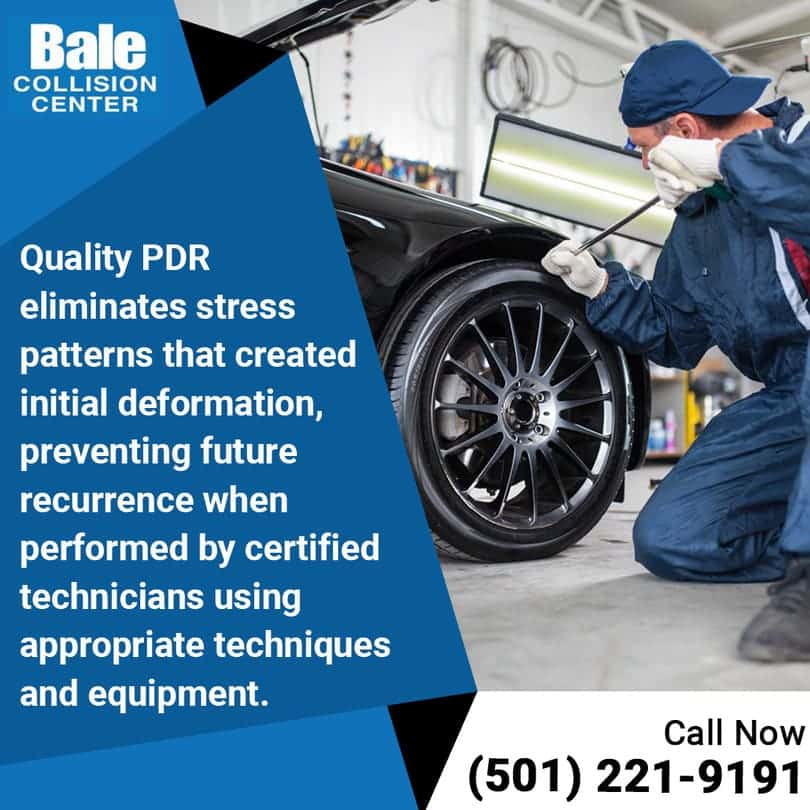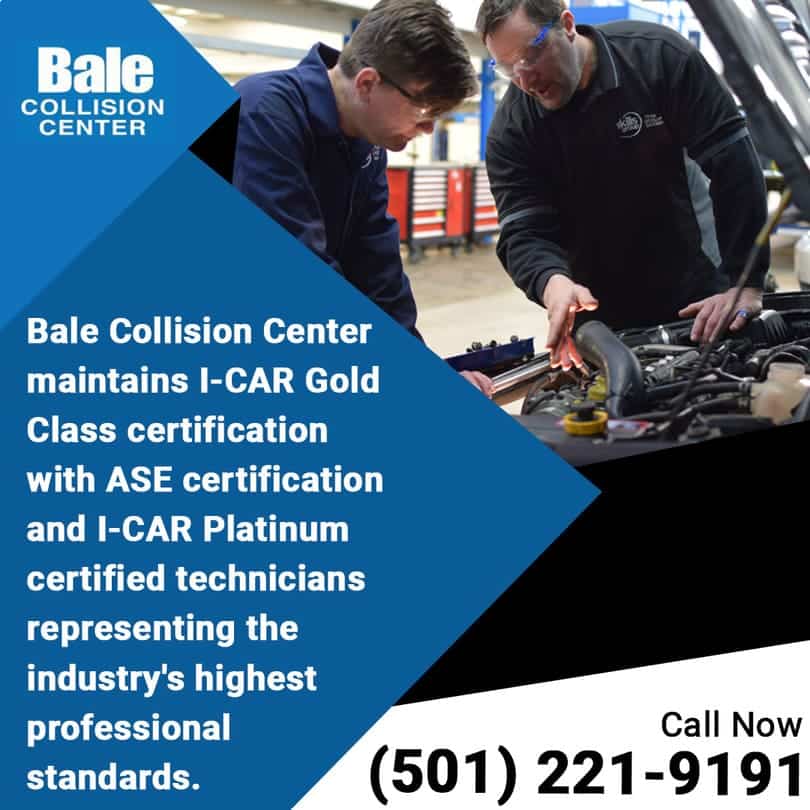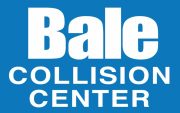Paintless dent repair has transformed how vehicle owners handle minor dents and dings, yet several misconceptions continue to circulate about this advanced repair method. At Bale Collision Center, one of the best PDR shops in Chenal Parkway, Little Rock, AR, our technicians regularly address customer concerns about PDR safety, effectiveness, and value. PDR preserves your vehicle’s original paint and eliminates the need for fillers or repainting, typically costing 30-70% less and can often be completed in just a few hours.
The most persistent myths include beliefs that PDR damages paint, provides temporary fixes, or works only on tiny dents. Professional paintless dent repair actually maintains your car’s factory finish while delivering permanent results on various dent sizes and types. Understanding these truths helps vehicle owners choose the most effective repair solution for their specific situation.

Misconception 1: PDR Damages Your Vehicle’s Paint
Modern vehicles use paint that is more flexible and malleable than older automotive finishes, allowing dents to be massaged out without compromising the paint surface. At Bale Collision Center, our PDR technicians use tools designed specifically to reshape metal panels while preserving the original finish.
How Professional Technique Protects Paint
Experienced paintless dent removaltechnicians use a range of special tools and techniques to remove impacts. They massage the dent carefully and slowly from inside the panel while applying gentle pressure and supporting the external section. This methodical approach prevents paint damage that might occur with improper technique or inadequate training.
Technicians have access to special tools with defined applications built into them, which lessen the risk of damaging the paint. Modern paint formulations used on today’s vehicles exhibit greater flexibility compared to older automotive finishes, making them better candidates for paintless repair techniques.
Paint Protection During PDR Process
The key factors protecting your paint during professional PDR include proper tool selection, controlled pressure application, and thorough damage assessment. Controlled pressure prevents overstretching, specialized tools minimize surface contact, and gradual reshaping maintains paint flexibility. Professional assessment identifies unsuitable cases before attempting repairs.
Misconception 2: DIY Paintless Dent Repair Works Just As Well
The internet and retail stores offer numerous do-it-yourself paintless dent repair kits, creating the misconception that PDR is simple for amateur attempts. DIY dent repair attempts often result in additional damage that requires professional correction.
Why Professional Training Matters
Professional PDR technicians use tabs, special adhesives, and lifting apparatus differently than DIY kits suggest. The main difference lies in a technician’s trained eyes, reflective source knowledge, and extensive practice. Professional technicians assess each dent using specialized lighting and reflection techniques to identify the exact repair approach needed.
Common DIY Mistakes That Create Damage
Plunging away dents can actually make the dents worse by creating uneven pressure distribution or bowing the metal outward, making proper repair nearly impossible afterward. Other problematic DIY approaches include using dry ice, hair dryers, or generic suction tools that create additional damage requiring more extensive dent repairs.
The learning curve for effective paintless dent repair spans months or years, not the few hours suggested by DIY kit instructions. Professional technicians have spent hundreds or thousands of hours perfecting their craft. At Bale Collision Center, our specialists possess extensive training and certification, which helps us provide expert PDR in Chenal Parkway, Little Rock, AR.
Misconception 3: Dents Return After PDR Treatment
Metal has a memory and wants to go back to its previous shape. Dents successfully repaired by PDR do not return. The misconception that dents return after PDR likely stems from observing poor-quality repairs performed by inexperienced technicians or DIY attempts.
Understanding Metal Memory Properties
The metal alloy used on modern cars features shape memory properties. This means that dents will not return after technicians complete quality PDR. Professional repair techniques restore the metal’s original molecular structure, eliminating the stress patterns that created the initial deformation.
What Makes Professional PDR Permanent
When PDR technicians repair a dent, they carefully reshape the metal with hundreds of tiny pushes, which restores the panel to its original shape and strength. This thorough approach addresses all affected areas, preventing partial repairs that might compromise long-term results.
There is one exception: a dented panel that has been stretched too far when initially damaged. Metal that has been stretched excessively will not lie flat again without shrinking. At Bale Collision Center, our technicians identify these limitations during initial assessment, recommending alternative dent repair methods when PDR cannot deliver permanent solutions.
Misconception 4: PDR Only Works on Small Dents
Many vehicle owners believe paintless dent repair works exclusively on tiny dings and minor surface imperfections. While PDR proves highly effective for minor dents caused by hail damage and door dings, skilled technicians can address larger damage areas.
Size vs. Depth Considerations
The determining factors include dent depth, location accessibility, and metal condition rather than size alone. The National Association of PDR Technicians (NAPDRT) states that dents up to the size of a dinner plate can often be repaired. If they’re shallow enough and paint‑intact, they’re still eligible for PDR. Smaller, deep dents may fail even if tiny. Professional assessment considers multiple variables to determine PDR suitability for each specific case.
Factors That Determine PDR Success
Professional evaluation considers depth and sharpness of the damaged area, panel accessibility for tool placement, paint condition and flexibility, metal stretching extent, and location on the vehicle structure. Our technicians at Bale Collision Center evaluate each case individually, considering these factors alongside our extensive experience with various dent types.
Large, shallow dents often respond better to PDR than small, deep impacts that may require traditional repair approaches. The dent’s location on the vehicle influences repair feasibility and success rates.
Misconception 5: Insurance Doesn’t Cover PDR Services
Cost concerns lead many vehicle owners to assume insurance companies prefer traditional repair methods over paintless dent repair. Many insurance companies prefer PDR because repair costs are lower, because they don’t have to pay as much for dent repairs. This preference benefits both insurers and policyholders through reduced claim costs and faster repair completion times.
Paintless dent repair is preferred by insurance for removing dents from cars that have received hail damage. Insurance adjusters recognize PDR’s effectiveness for hail damage, door dings, and similar impacts that don’t compromise the vehicle’s paint system.
Insurance Benefits of PDR Selection
Lower repair costs reduce deductible impact, faster completion minimizes rental car expenses, factory finish preservation maintains vehicle value, and reduced claim frequency through effective repairs. At Bale Collision Center, we work directly with all insurance companies, handling the claims process to simplify your repair experience.
Our established relationships with major insurers, including State Farm, Allstate, Liberty Mutual, USAA, Nationwide, and others, streamline approval processes for PDR in Chenal Parkway, Little Rock, AR.
Misconception 6: PDR Costs More Than Traditional Repair
Some consumers believe paintless dent repair costs more than conventional body shop services due to its specialized nature and advanced techniques. Professional paintless dent repair can cost 1/2 that of conventional body shop repair. This significant cost advantage stems from reduced material requirements and shorter labor times.
Traditional dent repair methods require sanding, body filler application, primer coating, color matching, paint application, and final polishing. Each step adds material costs and labor time to the final bill. PDR eliminates expenses associated with body filler, primer, paint, and extensive labor hours required for conventional repairs.
Long-term Value Benefits
Professional PDR preserves your vehicle’s resale value by maintaining the original factory finish. Since PDR involves massaging dings and dents fully out of your vehicle, it’s like the damage was never there. Unlike when your vehicle needs repainting, PDR erases the damage while restoring the vehicle’s value. This value retention provides long-term financial benefits beyond immediate repair savings.
PDR Limitations and Alternatives
Professional honesty includes recognizing situations where paintless dent repair cannot deliver the right results. Minor dents are repairable with PDR, but not all automotive damages are within the scope of the procedure’s capabilities. Our technicians assess each case honestly, recommending alternative repair methods when PDR limitations prevent satisfactory results.
When PDR Cannot Be Applied
Cracked or chipped paint requires traditional refinishing, extremely deep dents may need body filler application, edge damage often requires panel replacement, and previous body work may prevent PDR access. These limitations require transparency to help customers make informed decisions.
At Bale Collision Center, we offer complete collision repair services, including traditional body work for cases where PDR isn’t suitable. Our I-CAR Gold Class certification and advanced equipment provide quality results regardless of the repair method required.
Benefits of Choosing Bale Collision Center for PDR in Chenal Parkway, Little Rock, AR
Bale Collision Center brings 7 decades of auto body repair experience to the Little Rock area, with specialized PDR capabilities through our certified technicians. Our Chenal Parkway location provides convenient access for customers throughout western Little Rock and nearby communities.
Certified Expertise and Experience
Our technicians hold I-CAR Platinum certification, the highest level of professional training available in the collision repair industry. Our team has successfully handled thousands of dent scenarios, from minor parking lot dings to severe hail damage across Little Rock and surrounding areas.
Each technician completes ongoing training to stay current with evolving PDR techniques and modern vehicle materials. This continuous education, combined with decades of practical experience, allows us to tackle complex dent patterns, making us one of the best PDR shops in Chenal Parkway, Little Rock, AR.
Advanced Equipment and Technology
We utilize specialized paintless dent repair equipment designed for preserving your vehicle’s original finish. Our professional-grade lighting systems allow technicians to identify every detail of the damage, while precision tools enable accurate metal reshaping without affecting the paint.
The use of advanced technology allows us to handle complex dent patterns and challenging repair scenarios that require professional expertise. The combination of proper equipment and skilled technique produces factory-quality results that maintain your vehicle’s value and appearance.
Quality Assurance Standards
Bale Collision Center has earned a trusted reputation as one of the best PDR shops in Chenal Parkway, Little Rock, AR, for fast, reliable, and consistent services. Our quality assurance process begins with thorough damage assessment and continues through final inspection to guarantee superior results.
Every paintless dent repair undergoes multi-point quality checks at each stage of the process. Our technicians inspect the work under specialized lighting conditions to verify complete metal restoration and paint integrity. We document before and after conditions, providing you with visual confirmation of the repair quality.

Making Informed PDR Decisions
Paintless dent repair myths persist despite decades of proven success and technological advancement in the field. Knowing the facts about PDR safety, cost-effectiveness, and limitations helps vehicle owners make informed dent repair decisions. Professional paintless dent repair preserves your vehicle’s factory finish, maintains resale value, and provides environmentally responsible restoration at a fraction of traditional repair costs.
At Bale Collision Center, our certified technicians combine 72 years of collision repair experience with specialized PDR expertise. We work directly with all insurance companies and provide transparent assessments to help customers choose the most effective repair approach for their specific situation.
Don’t let misconceptions prevent you from considering paintless dent repair for your vehicle’s minor damage. Our professional evaluation process identifies PDR suitability while explaining all available options for your specific case. Whether dealing with hail damage, parking lot dings, or minor collision impacts, we provide honest assessments and quality PDR backed by our commitment to customer satisfaction.
Contact Bale Collision Center for Professional PDR in Chenal Parkway, Little Rock, AR
Contact Bale Collision Center at (501) 221-9191 or bccwlr@baleautomotive.comfor a free estimate. Our certified technicians will evaluate your damage and explain all repair options, helping you make the best choice for your vehicle and budget. Let our decades of experience and professional certification deliver the quality results your vehicle deserves.
